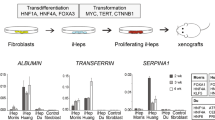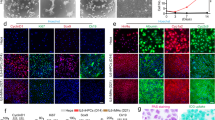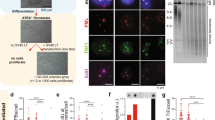Abstract
Hepatoblasts are bipotent progenitors of both hepatocytes and cholangiocytes. The lack of stable in vitro culture systems for such cells makes it necessary to generate liver progenitor cell lines by means of immortalization. In this study, we describe the long-term behaviour of a clone of simian foetal hepatic progenitor cells immortalized by Simian virus 40 (SV40) large T-antigen (T-Ag) flanked by loxP sites. Immortalization was associated with the re-expression of telomerase activity, which decreased at late passages (population doubling 120) after more than a year in culture. This decrease was concomitant to telomere shortening and karyotypic instability. However, the chromosomes carrying the p53 gene remained intact and long-term immortalized progenitor cells maintained contact inhibition and proliferative properties. They also displayed the features of a normal bipotent phenotype. We constructed a retroviral vector expressing an inducible Cre recombinase and transferred it into the immortalized progenitors. Activation of the Cre recombinase by 4-hydroxy-tamoxifen induced SV40 T-Ag excision, leading to the death of cells expressing Cre recombinase. Immortalized progenitors at late passages stopped growing and eventually disappeared after transplantation into the livers of immunocompromised mice. These cells provide a novel model to study hepatic differentiation and carcinogenesis.
This is a preview of subscription content, access via your institution
Access options
Subscribe to this journal
Receive 50 print issues and online access
$259.00 per year
only $5.18 per issue
Buy this article
- Purchase on Springer Link
- Instant access to full article PDF
Prices may be subject to local taxes which are calculated during checkout






Similar content being viewed by others
References
Ali SH and DeCaprio JA . (2001). Semin. Cancer Biol., 11, 15–23.
Allain JE, Dagher I, Mahieu-Caputo D, Loux N, Andreoletti M, Westerman K, Briand P, Franco D, Leboulch P and Weber A . (2002). Proc. Natl. Acad. Sci. USA, 99, 3639–3644.
Blackburn EH . (1991). Nature, 350, 569–573 review.
Blasco MA, Lee HW, Rizen M, Hanahan D, Dopinho R and Greider CW . (1997). Ciba Found. Symp., 211, 160–170.
Blumrich M, Zeyen-Blumrich U, Pagels P and Petzinger E . (1994). Eur. J. Cell. Biol., 64, 339–347.
Bryan TM and Reddel RR . (1997). Eur. J. Cancer, 33, 767–773.
Casillas MA, Brotherton SL, Andrews LG, Ruppert JM and TollefsBol TO . (2003). Gene, 316, 57–65.
Challita PM and Kohn DB . (1994). Proc. Natl. Acad. Sci. USA, 91, 2567–2571.
Colucci F, Soudais C, Rosmaraki E, Vanes L, Tybulewicz VLJ and Di Santo JP . (1999). J. Immunol., 162, 2761–2765.
Counter C, Avilion A, LeFreuvre C, Stewart N, Greider C, Harley C and Bacchetti S . (1992). EMBO J., 5, 1921–1929.
Counter C, Hahn W, Wei W, Dickinson Caddle S, Beijersbergen R, Lansdorp P, Sedivy J and Weinberg E . (1998). Proc. Natl. Acad. Sci. USA, 95, 14723–14728.
Dabeva MD, Laconi E, Oren R, Petkov PM, Hurston E and Shafritz DA . (1998). Cancer Res., 58, 5825–5834.
de Lange T . (2002). Oncogene, 21, 532–540 review.
Dunham MA, Neumann AA, Fasching CL and Reddel RR . (2000). Nat. Genet., 26, 447–450.
Dutrillaux B, Biemont MC, Viegas-Pequignot E and Laurent C . (1979). Cytogenet. Cell. Genet., 23, 77–83.
Dutrillaux B and Couturier J . (1981). La pratique de l'analyse chromosomique. Mason: Paris.
Erez N, Zamir E, Gour BJ, Blaschuk OW and Geiger B . (2004). Exp. Cell Res., 294, 366–378.
Grompe M, Laconi E and Shafritz DA . (1999). Semin. Liver Dis., 19, 7–14.
Hamad N, Banik S and Counter C . (2002). Oncogene, 21, 7121–7125.
Hayflick L and Moorhead PS . (1961). Exp. Cell Res., 25, 585–621.
Henson JD, Neumann AA, Yeager TR and Reddel RR . (2002). Oncogene, 21, 598–610.
Hoffschir F, Ricoul M and Dutrillaux B . (1988). Cytogenet. Cell Genet., 49, 264–268.
Hultdin M, Gronlund E, Norrback K, Eriksson-Lindstrom E, Just T and Roos G . (1998). Nucleic Acids Res., 26, 3651–3656.
Kakuo S, Asaoka K and Ide T . (1999). Biochem. Biophys. Res. Commun., 263, 308–314.
Kim BH, Sung SR, Choi EH, Kim YI, Kim KJ, Dong SH, Kim HJ, Chang YW, Lee JI and Chang R . (2000). Mol. Med., 32, 29–37.
Kobayashi N, Fujiwara T, Westerman K, Inoue Y, Sakagushi M, Nogushi H, Miyazaki M, Cai J, Tanaka N, Fox I and Leboulch P . (2000). Science, 287, 1258–1262.
Kyo S, Nakamura M, Kiyono T, Maida Y, Kanaya T, Tanaka M, Yatabe N and Inoue M . (2003). Am. J. Pathol., 163, 2259–2269.
Laconi S, Curreli F, Diana S, Pasciu D, De Filippo G, Sarma DS, Pani P and Laconi E . (1999). J. Hepatol., 31, 1069–1074.
Laconi S, Pillai S, Porcu PP, Shafritz DA, Pani P and Laconi E . (2001). Am. J. Pathol., 158, 771–777.
Leblanc V and May P . (2002). Medicine/Science, 18, 577–584.
Loayza D and De Lange T . (2003). Nature, 424, 1013–1018.
Lundberg A, Randell S, Stewart S, Elenbaas B, Hartwell K, Brooks M, Fleming M, Olsen J, Miller S, weinberg R and Hahn W . (2002). Oncogene, 21, 4577–4586.
Lustig AJ . (1999). Proc. Natl. Acad. Sci. USA, 96, 3339–3341.
Mahieu-Caputo D, Allain JE, Branger J, Coulomb A, Delgado JP, Mainot S, Andreoletti M, Frydman R, Leboulch P, Di Santo JP, Capron F and Weber A . (2004). Human Gene Ther., 15, 1219–1228.
May P and May E . (1999). Oncogene, 18, 7621–7636.
Ouellette MM, Liao M, Herbert BS, Johnson M, Holt SE, Liss HS, Shay JW and Wright WE . (2000). J. Biol. Chem., 275, 10072–10076.
Pani P, Laconi S, Pillai S, Scintu F, Curreli F, Shafritz DA and Laconi E . (1999). J. Hepatol., 31, 354–359.
Pipas JM and Levine AJ . (2001). Semin. Cancer Biol., 11, 23–30.
Pommier JP, Gauthier L, Livartowski J, Galanaud P, Boue F, Dulioust A, Marce D, Ducray C, Sabatier L, Lebeau J and Boussin FD . (1997). Virology, 231, 148–154.
Ramirez RD, Morales CP, Herbert BS, Rohde JM, Passons C, Shay JW and Wright WE . (2001). Genes Dev., 15, 398–403.
Rufer N, Dragowska W, Thornbury G, Roosnek E and Lansdorp PM . (1998). Nat. Biotechnol., 16, 743–747.
Seger YR, Garcia-Cao M, Piccinin S, Cunsolo CL, Doglioni C, Blasco MA, Hannon GJ and Maestro R . (2002). Cancer Cell., 2, 401–413.
Shimizu Y, Suzuki J, Terao K and Ishida T . (2003). Mech. Ageing Dev., 124, 237–244.
Steensel BV and De Lange T . (1997). Nature, 385, 740–743.
Steinert S, White DM, Zou Y, Shay JW and Wright W . (2002). Exp. Cell Res., 272, 146–152.
Stewart S, Hahn W, O'Connor B, Banner E, Lundberg A, Modha P, Mizuno H, Brooks M, Flemming N, Zimonjic D and Popescu N . (2002). Proc. Natl. Acad. Sci. USA, 99, 12606–12611.
Thomas D, Pritchard J, Davidson R, McKiernan P, Grundy RG and de Ville de Goyet J . (2003). Eur. J. Cancer, 39, 2200–2204.
Toouli C, Huschtscha L, Neumann A, Noble J, Colgin L, Hukku B and Reddel R . (2002). Oncogene, 21, 128–139.
Vallier L, Mancip J, Markossian S, Lukaszewicz A, Dehay C, Metzger D, Chambon P, Samarut J and Savatier P . (2001). Proc. Natl. Acad. Sci. USA, 98, 2467–2472.
Wang J, Ying Xie L, Allan S, Beach D and Hannon GJ . (1998). Genes Dev., 12, 1769–1774.
Woodworth CD, Kreider JW, Mengel L, Miller T, Meng YL and Isom H . (1988). Mol. Cell. Biol., 8, 4492–4501.
Wright WE and Shay JW . (1992a). Exp. Gerontol., 27, 383–389.
Wright WE and Shay JW . (1992b). Trends Genet., 8, 193–197.
Zhu J, Wang H, Bishop JM and Blackburn EH . (1999). Proc. Natl. Acad. Sci. USA, 96, 3723–3728.
Acknowledgements
We thank Drs D Mahieu and I Dagher for help in animal surgery, L Cam for helpful discussion and Mrs B Savary for assistance in artwork. This research was supported by the EC, QLK3CT 1999-00364, and grants from Inserm ATC Biothérapies, Association Française contre les Myopathies, the Fondation pour la Recherche Médicale, the Etablissement Français des Greffes, the ‘GIS Maladies Rares’ and the Institut Pasteur. JE Allain was supported by Fondation pour la Recherche Médicale.
Author information
Authors and Affiliations
Corresponding author
Rights and permissions
About this article
Cite this article
Delgado, JP., Parouchev, A., Allain, JE. et al. Long-term controlled immortalization of a primate hepatic progenitor cell line after Simian virus 40 T-Antigen gene transfer. Oncogene 24, 541–551 (2005). https://doi.org/10.1038/sj.onc.1208089
Received:
Revised:
Accepted:
Published:
Issue Date:
DOI: https://doi.org/10.1038/sj.onc.1208089
Keywords
This article is cited by
-
Establishment and characterisation of a novel bovine SV40 large T-antigen-transduced foetal hepatocyte-derived cell line
In Vitro Cellular & Developmental Biology - Animal (2016)
-
Immortalization of human precartilaginous stem cells by transfecting SV40Tag
Journal of Huazhong University of Science and Technology [Medical Sciences] (2009)
-
Immortalization of pancreatic stellate cells as an in vitro model of pancreatic fibrosis: deactivation is induced by matrigel and N-acetylcysteine
Laboratory Investigation (2005)



